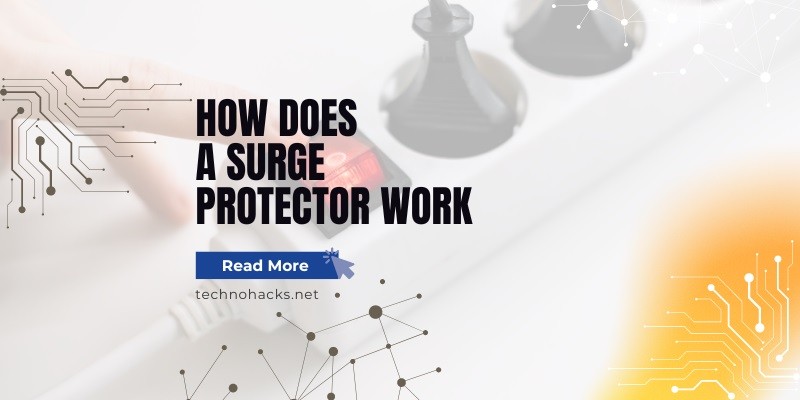Last Updated on May 5, 2025 by Jim C.
Surge protectors are essential devices that safeguard our electronic equipment from potentially damaging power fluctuations. Understanding how they function and choosing the right one for your needs can help protect your valuable devices and extend their lifespan. Let’s explore the inner workings of surge protectors and the key factors to consider when selecting one.
Power Surges
A power surge, also known as transient voltage, is a brief increase in voltage significantly above the standard level in an electrical circuit. In the United States, the standard voltage for household and office wiring is 120 volts. When the voltage rises above this level, it can pose a threat to electronic devices.
Power surges can occur due to various reasons:
- Lightning strikes
- Power outages and subsequent restoration
- Electrical grid switching
- Large appliances cycling on and off
- Faulty wiring
These surges can last from microseconds to several seconds. While large surges can cause immediate damage, smaller, more frequent surges can gradually degrade electronic components over time.
How Surge Protectors Function
The primary purpose of a surge protector is to detect excess voltage and divert it away from the connected devices. Most surge protectors use a component called a Metal Oxide Varistor (MOV) to accomplish this.
Here’s how an MOV works:
- The MOV is connected between the power line and the grounding line.
- It consists of a metal oxide material sandwiched between two semiconductors.
- Under normal voltage conditions, the MOV has high resistance and doesn’t affect the circuit.
- When voltage exceeds a certain threshold, the MOV’s resistance drops significantly.
- This allows it to conduct excess current away from the connected devices and into the grounding wire.
- Once the voltage returns to normal, the MOV’s resistance increases again, effectively “closing the valve”.
Some surge protectors may also use other components like gas discharge arrestors (GDAs) or silicon avalanche diodes (SADs) for additional protection.
Types of Surge Protectors
There are several types of surge protectors available, each designed for specific applications:
- Power Strip Surge Protectors: These are the most common type, offering multiple outlets and portability. They’re ideal for home entertainment systems and computer setups.
- Wall-Mount Surge Protectors: These plug directly into wall outlets and are more compact. They’re suitable for areas with limited space or for travel.
- Whole House Surge Protectors: These are installed at the main electrical panel and protect all devices connected to your home’s electrical system. They’re particularly useful in areas prone to lightning strikes.
- Type 1 Surge Protection Devices (SPDs): These are designed for installation at the service entrance and can handle high-energy surges from lightning strikes.
- Type 2 SPDs: These are installed on the load side of the main service panel and protect against lower energy surges.
- Type 3 SPDs: These are point-of-use devices designed to protect specific equipment.
Key Features to Consider
When choosing a surge protector, several specifications and features are important to consider:
- Joule Rating: This indicates the total amount of energy the surge protector can absorb before it fails. A higher joule rating generally means better protection and a longer lifespan. For most home electronics, look for a rating of at least 600 joules.
- Clamping Voltage: This is the voltage at which the surge protector activates. A lower clamping voltage (preferably under 400 volts) provides better protection.
- Response Time: This measures how quickly the surge protector responds to a voltage spike. Look for devices with a response time of 1 nanosecond or less.
- Number and Type of Outlets: Ensure the surge protector has enough outlets for your needs, including any special outlets like coaxial or Ethernet ports.
- UL Rating: Look for surge protectors that meet the UL 1449 standard, which ensures they’ve been tested for safety and effectiveness.
- Indicator Lights: These show whether the surge protection is functioning correctly.
- Warranty: A good warranty can provide additional peace of mind. Some manufacturers offer equipment protection policies that cover connected devices.
Proper Usage and Maintenance
To get the most out of your surge protector:
- Don’t overload the surge protector. Each device has a maximum amperage rating.
- Avoid daisy-chaining multiple surge protectors.
- Replace your surge protector every few years, as its effectiveness decreases over time.
- If you live in an area prone to lightning strikes, unplug sensitive equipment during storms.
- Consider using a whole-house surge protector in addition to point-of-use devices for comprehensive protection.
Limitations of Surge Protectors
While surge protectors are invaluable for protecting against most power fluctuations, they have limitations:
- They cannot protect against direct lightning strikes in your home.
- They have a finite lifespan and will eventually wear out.
- They require proper grounding to function effectively.
Conclusion
Surge protectors play a crucial role in safeguarding our increasingly electronic world. By understanding how they work and what features to look for, you can make an informed decision when purchasing one. Remember, the cost of a good surge protector is minimal compared to the value of the equipment it protects. Investing in quality surge protection can save you from costly repairs or replacements down the line, ensuring your devices continue to function reliably for years to come.

